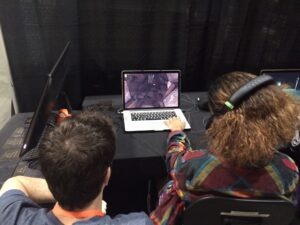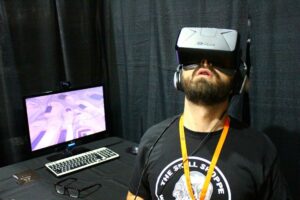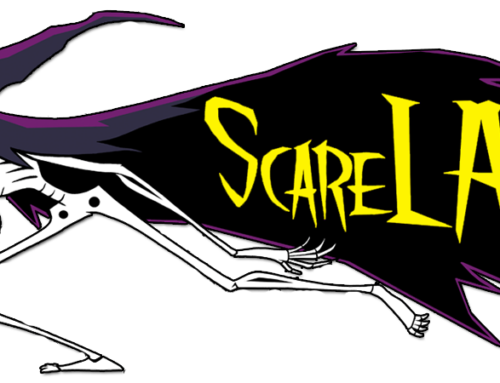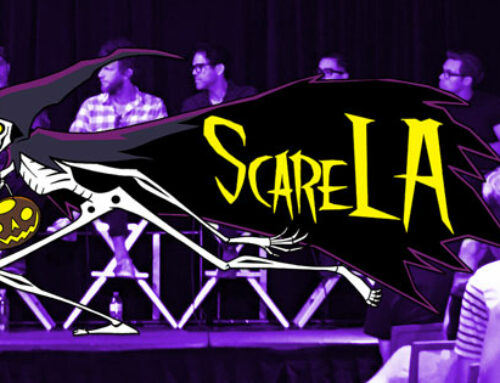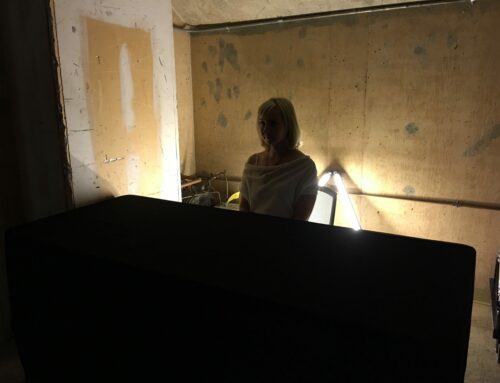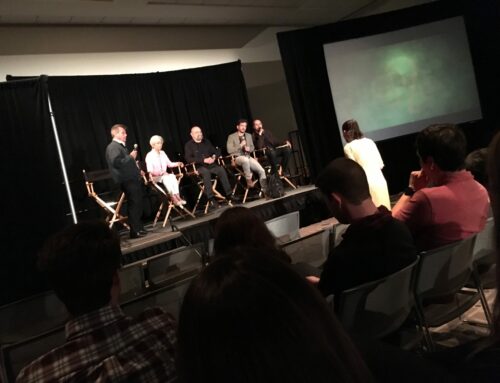I may not have time for this, I thought. But instinct urged me to stay.
I had participated in previous Oculus Rift experiences (including Blumhouse’s Insidious trailer, “The Seance” from Spectral Illusions, and Virtual Scream’s “Phobias”) – so I thought I could approximate the experience I was signing up for.
It turned out I was wrong.
One of the producers greeted me with a warm smile, explaining that the gaming experience they provide includes a biofeedback heart rate sensor, hooked up to the gamer. As fear and the primal ‘fight or flight’ response increase, the game increases in difficulty, “punishing” the gamer by lashing out, upping the ante. In fact, both their namesake game and the Oculus Rift experience come with a waiver, just in case things get too real.
Now I simply can’t walk away. I feel pleased, as if I’d stumbled upon hidden treasure among the show floor. I eagerly join the queue.
I spoke briefly with Michael Annetta, the producer for Nevermind. Creative Director Erin Reynolds was heading a panel at the time. (For more on that, Jeff wrote a great piece). It was explained to me that this project began as her master’s thesis, “this is basically her dream project realized.” I was lucky enough to later speak with Erin herself. Her passion, energy and dedication to this creative venture is tangible and contagious.
From college thesis, a full fledged game was born, now available to play at home through Steam. There you can find referrals as to which biofeedback sensors are compatible, and recreate the experience. Though fairly new in it’s inception (it’s been around about a year) – they have only touched the surface of where this technology can go.
Which brings me to the real reason I’m writing. At ScareLA, we saw the Flying Mollusk team debut their latest step in gaming innovation: an Oculus Rift sneak peak version of Nevermind. This was the one I wanted to try.
Set to last approximately 5-10 minutes, the object of the game was to search the scene of a trauma and collect photographs related to that experience. Only one photo would corroborate the event. “So how will I identify which is the real picture?” I ask. Annetta smiles, this was up to me to discover by taking in cues from this new world.
What sets this game apart from other VR experiences is that instead of being guided through a preset program, the player calls the shots. The visuals are 4D and all-encompassing, but in your hands you hold a controller that allows free movement, as well as the ability to open doors, pick up objects, etc. Annetta places the headset and earphones over my head and the game begins.
I find myself in a courtyard. The scene feels drugged, disorientating, something resembling a page from ‘Alice in Wonderland.’ I’m surprised to feel a bit of vertigo as my eyes acclimate to the all-consuming sight and sound. Sharp, angular buildings tilt and tower around me as I navigate. The dimensions are unnerving. Calming, hypnotic music fills my ears. A light breeze sways grass and flowers in the garden. Instantly I feel the pressure and anxiety of the world inside my head, the world out on the show floor melt away. I’m absorbed into Nevermind.
After a brief look around, I exit the courtyard into a garage. Once inside, the mood changes drastically. Tension mounts abruptly. I hear the sounds of cars screeching, glass and metal breaking, sirens blaring. The ambient music is pulsating and anxiety-inducing. On the walls I see bloodied, smashed up vehicles, ceiling to floor. I recognize that this is an experience that someone has been unable to escape, and feel sorrow. Not much else is in this room to find, by my cursory glance.
After moving through I find myself in a circular room of faces. I am surrounded by fear – repetitive, looping and frozen. In the center is a tree, figurately rooting me back to the courtyard where I’d begun. The tear-stained faces, one on top of the other, extend all the way to the ceiling. The eyes convey distress and shock, some empty, some glancing to their left, all screaming. They are locked in an inescapable loop, reliving the crash. The music in this room feels like a mysterious echo. Empathy kicks in and I am compelled to search, knowing this is where the missing link will be. I follow the direction of the eyes.
After wandering and searching possibly a bit too long, not wanting the experience to end, I locate the photograph which was hiding in plain sight. My task is now to return it to the garage (scene of the trauma) and exit into the courtyard but I am lost. Again it occurs to me that perhaps this is how the trauma victim must feel – lost in fear – and I wonder if this move was intentional on the game designers part. I lift up one earpiece and call out to (producer) Annetta “How do I get out of here?” “Look for the face that is looking at you with eyes closed,” he responds.
Upon finding that face, one of my favorite quotes comes to mind, “I find myself in the middle of an eye, watching myself in its blank stare.”
I move toward that open-ended face, into the garage, out into the courtyard, and at last the game is complete. The headset is removed. “Incredible. I’ve got to write about this.” Were the first words out of my mouth.
I left the experience calm and lost in thought. If a game like this can turn my frenzied day around in 5 minutes, I know it has incredible power. I wonder about the healing potential this could hold for trauma victims, as well as whether it could have the opposite effect. I also think about the nature of reality – specifically, how our own minds create a similar filter. When I was in the digitally fabricated experience of Nevermind, the tangible world with it’s worries, pain and drama became muted.
From the perspective of an VR newbie – I was impressed. This is a relatively young field, and market with unlimited potential. I know their cutting-edge project will continue to soar to new heights and I feel so lucky to have been among the first to experience it. I will always be able to say “I knew them when…” If you’re looking for an innovative gaming adventure unlike anything else currently available, keep a close eye on… Nevermind.
And remember, “The Greatest Enemy is the One Inside Your Head.”
To play at home, check out Nevermind online at Steam.
And be sure to stay tuned to Flying Mollusk for more updates on their work and/or future demo experiences![/vc_column_text][/vc_column][/vc_row][vc_row][vc_column width=”1/1″][banner728 banner=”557356c28958a”][/vc_column][/vc_row]

